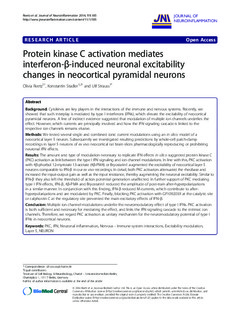| dc.contributor.author | Reetz, Olivia | |
| dc.contributor.author | Stadler, Konstantin | |
| dc.contributor.author | Strauss, Ulf | |
| dc.date.accessioned | 2019-11-01T08:05:14Z | |
| dc.date.available | 2019-11-01T08:05:14Z | |
| dc.date.created | 2015-01-07T16:05:23Z | |
| dc.date.issued | 2014 | |
| dc.identifier.citation | Journal of Neuroinflammation. 2014, . | nb_NO |
| dc.identifier.issn | 1742-2094 | |
| dc.identifier.uri | http://hdl.handle.net/11250/2626009 | |
| dc.description.abstract | Background
Cytokines are key players in the interactions of the immune and nervous systems. Recently, we showed that such interplay is mediated by type I interferons (IFNs), which elevate the excitability of neocortical pyramidal neurons. A line of indirect evidence suggested that modulation of multiple ion channels underlies the effect. However, which currents are principally involved and how the IFN signaling cascade is linked to the respective ion channels remains elusive.
Methods
We tested several single and combined ionic current modulations using an in silico model of a neocortical layer 5 neuron. Subsequently we investigated resulting predictions by whole-cell patch-clamp recordings in layer 5 neurons of ex vivo neocortical rat brain slices pharmacologically reproducing or prohibiting neuronal IFN effects.
Results
The amount and type of modulation necessary to replicate IFN effects in silico suggested protein kinase C (PKC) activation as link between the type I IFN signaling and ion channel modulations. In line with this, PKC activation with 4β-phorbol 12-myristate 13-acetate (4β-PMA) or Bryostatin1 augmented the excitability of neocortical layer 5 neurons comparable to IFN-β in our ex vivo recordings. In detail, both PKC activators attenuated the rheobase and increased the input-output gain as well as the input resistance, thereby augmenting the neuronal excitability. Similar to IFN-β they also left the threshold of action potential generation unaffected. In further support of PKC mediating type I IFN effects, IFN-β, 4β-PMA and Bryostatin1 reduced the amplitude of post-train after-hyperpolarizations in a similar manner. In conjunction with this finding, IFN-β reduced M-currents, which contribute to after-hyperpolarizations and are modulated by PKC. Finally, blocking PKC activation with GF109203X at the catalytic site or calphostin C at the regulatory site prevented the main excitatory effects of IFN-β.
Conclusion
Multiple ion channel modulations underlie the neuromodulatory effect of type I IFNs. PKC activation is both sufficient and necessary for mediating the effect, and links the IFN signaling cascade to the intrinsic ion channels. Therefore, we regard PKC activation as unitary mechanism for the neuromodulatory potential of type I IFNs in neocortical neurons. | nb_NO |
| dc.language.iso | eng | nb_NO |
| dc.publisher | BioMed Central | nb_NO |
| dc.rights | Navngivelse 4.0 Internasjonal | * |
| dc.rights.uri | http://creativecommons.org/licenses/by/4.0/deed.no | * |
| dc.title | Protein kinase C activation mediates interferon-β-induced neuronal excitability changes in neocortical pyramidal neurons | nb_NO |
| dc.type | Journal article | nb_NO |
| dc.type | Peer reviewed | nb_NO |
| dc.description.version | publishedVersion | nb_NO |
| dc.source.pagenumber | 14 | nb_NO |
| dc.source.journal | Journal of Neuroinflammation | nb_NO |
| dc.identifier.doi | 10.1186/s12974-014-0185-4 | |
| dc.identifier.cristin | 1192701 | |
| dc.description.localcode | Open Access CC-BY | nb_NO |
| cristin.unitcode | 194,64,25,0 | |
| cristin.unitname | Institutt for energi- og prosessteknikk | |
| cristin.ispublished | true | |
| cristin.fulltext | original | |
| cristin.qualitycode | 1 | |

